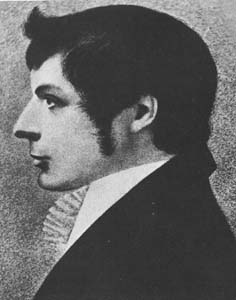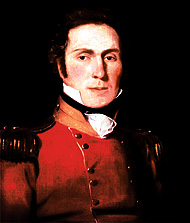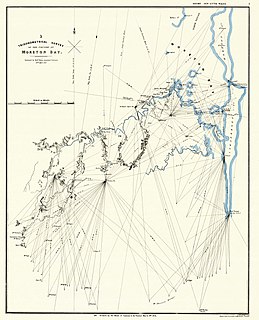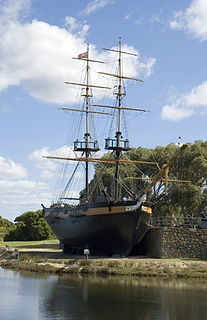Related Research Articles

The Brisbane River is the longest river in South-East Queensland, Australia, and flows through the city of Brisbane, before emptying into Moreton Bay on the Coral Sea. John Oxley, the first European to explore the river, named it after the Governor of New South Wales, Sir Thomas Brisbane in 1823. The penal colony of Moreton Bay later adopted the same name, eventually becoming the present city of Brisbane. The river is a tidal estuary and the water is brackish from its mouth through the majority of the Brisbane metropolitan area westward to the Mount Crosby Weir. The river is wide and navigable throughout the Brisbane metropolitan area.

John Joseph William Molesworth Oxley was an explorer and surveyor of Australia in the early period of British colonisation. He served as Surveyor General of New South Wales and is perhaps best known for his two expeditions into the interior of New South Wales and his exploration of the Tweed River and the Brisbane River in what is now the state of Queensland.

Allan Cunningham was an English botanist and explorer, primarily known for his travels in Australia to collect plants.

Captain Patrick Logan was the commandant of the Moreton Bay Penal Settlement from 1826 until his death in 1830 at the hands of Aboriginal Australians who objected to him entering their lands. As he had been hated by convicts, there were rumours that escaped convicts living in the bush had attacked him, but there is no evidence of this.

Stradbroke Island, also known as Minjerribah, was a large sand island that formed much of the eastern side of Moreton Bay near Brisbane, Queensland until the late 19th century. Today the island is split into two islands: North Stradbroke Island and South Stradbroke Island, separated by the Jumpinpin Channel.

Brisbane's recorded history dates from 1799, when Matthew Flinders explored Moreton Bay on an expedition from Port Jackson, although the region had long been occupied by the Yugara and Turrbal aboriginal tribes. The town was conceived initially as a penal colony for British convicts sent from Sydney. Its suitability for fishing, farming, timbering, and other occupations, however, caused it to be opened to free settlement in 1838. The town became a municipality in 1859 and a consolidated metropolitan area in 1924. Brisbane encountered major flooding disasters in 1893, 1974 and 2011. Significant numbers of US troops were stationed in Brisbane during World War II. The city hosted the 1982 Commonwealth Games, World Expo 88, and the 2014 G20 Brisbane summit.

Yeronga is a residential suburb of the City of Brisbane, Queensland, Australia located on the Brisbane River 7 kilometres (4.3 mi) south of the Brisbane central business district.
The following lists events that happened during 1824 in Australia.

Thomas Pamphlett (1788?–1838), sometimes Pamphlet, also known as James Groom, was a convict in colonial Australia. He is best known for his time as a castaway in the Moreton Bay area, halfway up the eastern coast of Australia, in 1823. He was marooned with two others, Richard Parsons and John Finnegan, until rescued by explorer John Oxley on HMS Mermaid on 29 November of that year. They were the first white people to live in the area.
John Finnegan, a convict of the colony of New South Wales, was one of four men who set off on a timber getting mission from Sydney bound for Illawarra in 1823. The men were caught in a severe storm and driven north 728 km to Moreton Island off the coast of Brisbane, becoming the first Europeans to live in the area and the first to discover the Brisbane River.
John Thompson, a convict of the colony of New South Wales, was one of four men who set off on a timber getting mission from Sydney bound for Illawarra in 1823. The men were caught in a severe storm and driven north 728 km to Moreton Island of the coast of Brisbane, becoming the first Europeans to live in the area and the first to discover the Brisbane River.

Amity was a 148-ton brig used in several notable voyages of exploration and settlement in Australia in the early nineteenth century.

The Flinders Peak Group is an unnamed range of hills located on the northern edge of the Scenic Rim Region, south west of Logan City and south east of the City of Ipswich in South East Queensland, Australia. The summit in the Range is Flinders Peak reaching 680 metres (2,230 ft) above sea level.

South Passage is channel between the South Pacific Ocean and Moreton Bay. The other entrances to the bay are the North Passage and Jumpinpin Channel in the south.

HMS Mermaid was a cutter built in Howrah, India, in 1816. The British Royal Navy purchased her at Port Jackson in 1817. The Navy then used her to survey the Australian coasts. In 1820 she grounded and in 1823 was condemned for survey work. The Navy sold her to the colonial government which used her to run errands until she was wrecked in 1829.

European land exploration of Australia deals with the opening up of the interior of Australia to European settlement which occurred gradually throughout the colonial period, 1788–1900. A number of these explorers are very well known, such as Burke and Wills who are well known for their failed attempt to cross the interior of Australia, as well as Hamilton Hume and Charles Sturt.
The Djindubari, also written Jindoobarrie or Joondubarri, were an indigenous Australian people of southern Queensland, whose traditional lands were located on Bribie Island. They are thought to be a horde or clan of the Undanbi.
The Nunukul, also spelt Noonuccal and known also as Moondjan are an Aboriginal Australian people, one of three Quandamooka peoples, who traditionally lived on Minjerribah, in Moreton Bay Area and in mainland Brisbane regions.
The Undanbi were an indigenous Australian tribe of southern Queensland.
The following is a timeline of the history of the city of Brisbane, Queensland, Australia.
References
Steele, John Gladstone: 'The Explorers of the Moreton Bay District 1770-1830', St Lucia, 1972, 386 pages documentary, illustrated.